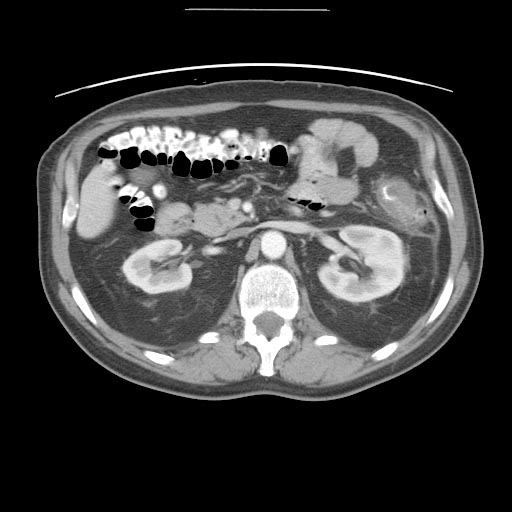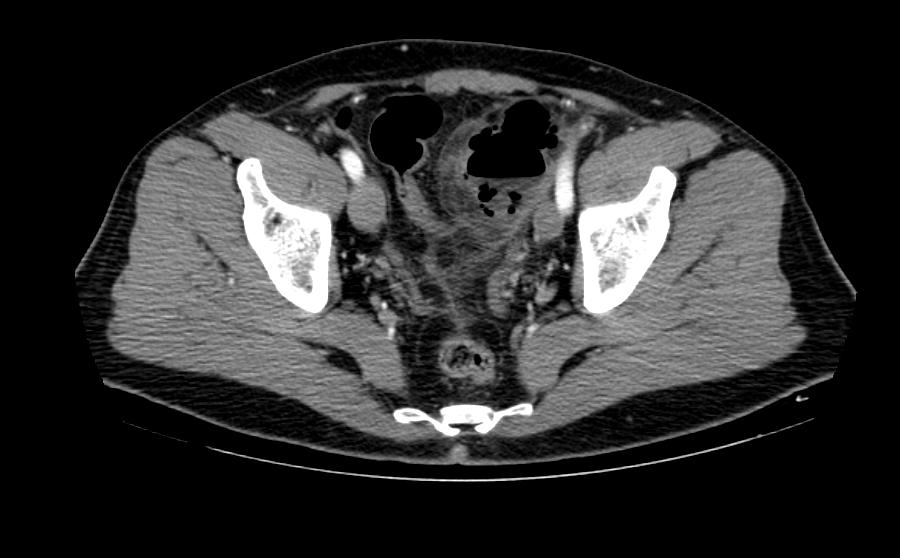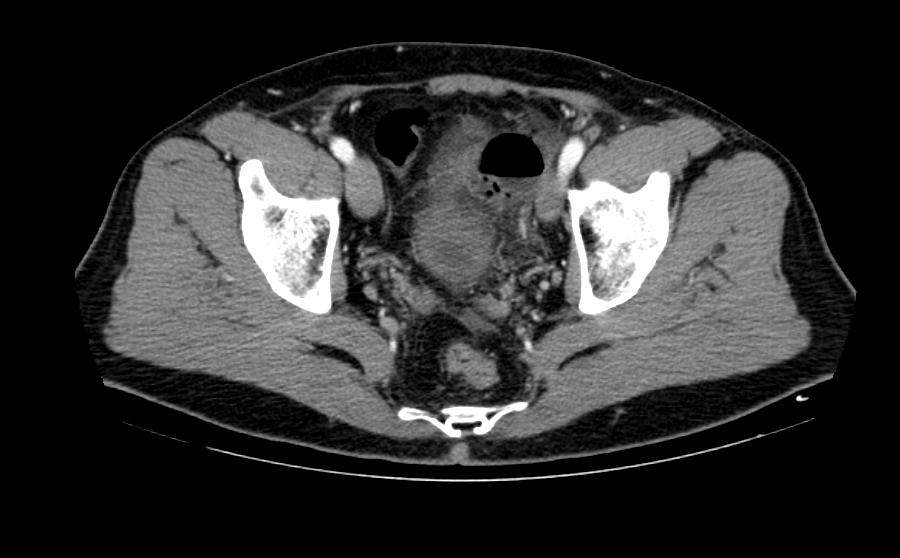Diverticulitis CT: Difference between revisions
| Line 7: | Line 7: | ||
==Computed Tomography== | ==Computed Tomography== | ||
CT scans role in diagnosing diverticulitis is controversial between who | CT scans role in diagnosing diverticulitis is controversial between those who see it as useful for the diagnosis and others who want to reduce using it for some patients. However, CT scan still one of the best diagnostic approaches and of a high specificity to diverticulitis up till now. CT scan is important in diagnosing diverticulitis for further management and treatment. The following can be observed in colon CT imaging:<ref name="pmid6739821">{{cite journal| author=Hulnick DH, Megibow AJ, Balthazar EJ, Naidich DP, Bosniak MA| title=Computed tomography in the evaluation of diverticulitis. | journal=Radiology | year= 1984 | volume= 152 | issue= 2 | pages= 491-5 | pmid=6739821 | doi=10.1148/radiology.152.2.6739821 | pmc= | url=https://www.ncbi.nlm.nih.gov/entrez/eutils/elink.fcgi?dbfrom=pubmed&tool=sumsearch.org/cite&retmode=ref&cmd=prlinks&id=6739821 }} </ref> | ||
*Colonic and paracolic [[inflammation]] in the presence of underlying [[Diverticular|diverticula]] (diverticula are identified on CT scans as outpouchings of the colonic wall). | *Colonic and paracolic [[inflammation]] in the presence of underlying [[Diverticular|diverticula]] (diverticula are identified on CT scans as outpouchings of the colonic wall). | ||
Revision as of 18:43, 25 July 2017
|
Diverticulitis Microchapters |
|
Diagnosis |
|---|
|
Treatment |
|
Case Studies |
|
Diverticulitis CT On the Web |
|
American Roentgen Ray Society Images of Diverticulitis CT |
Editor-In-Chief: C. Michael Gibson, M.S., M.D. [1]; Associate Editor(s)-in-Chief: Cafer Zorkun, M.D., Ph.D. [2]
Overview
The CT scan is very sensitive (98%) in diagnosing diverticulitis. Using oral or intravenous contrast will have a good impact on the CT scan accuracy. It may also identify patients with more complicated diverticulitis, such as those with an associated abscess. CT also allows for radiologically guided drainage of associated abscesses, possibly sparing a patient from immediate surgical intervention. CT scan is not only important in the diagnosis of diverticulitis but also needed to exclude the possibility of cancer in these patients.[1][2][3][4][5]
Computed Tomography
CT scans role in diagnosing diverticulitis is controversial between those who see it as useful for the diagnosis and others who want to reduce using it for some patients. However, CT scan still one of the best diagnostic approaches and of a high specificity to diverticulitis up till now. CT scan is important in diagnosing diverticulitis for further management and treatment. The following can be observed in colon CT imaging:[6]
- Colonic and paracolic inflammation in the presence of underlying diverticula (diverticula are identified on CT scans as outpouchings of the colonic wall).
- Symmetric thickening of the colonic of approximately 4-5 mm is common.
- Enhancement of the colonic wall is commonly noted. This usually has inner and outer high-attenuation layers, with a thick middle layer of low attenuation.
- Free diverticular perforation results in the extravasation of air and fluid into the pelvis and peritoneal cavity.
- Air in the bladder in the presence of a nearby segment of diverticulitis is suggestive of a colovesical fistula.
- Identification of the abscess in cases of complicated diverticulitis. It appears like localized fluid collection surrounded by inflammed tissue.
- Dilated loops may be observed with air fluid levels.
Patient #1: CT images demonstrate diverticulitis
Patient #2: CT images demonstrate a diverticular abscess
References
- ↑ Schreyer AG, Layer G, German Society of Digestive and Metabolic Diseases (DGVS) as well as the German Society of General and Visceral Surgery (DGAV) in collaboration with the German Radiology Society (DRG) (2015). "S2k Guidlines for Diverticular Disease and Diverticulitis: Diagnosis, Classification, and Therapy for the Radiologist". Rofo. 187 (8): 676–84. doi:10.1055/s-0034-1399526. PMID 26019048.
- ↑ Neff CC, vanSonnenberg E (1989). "CT of diverticulitis. Diagnosis and treatment". Radiol Clin North Am. 27 (4): 743–52. PMID 2657852.
- ↑ Ambrosetti P (2016). "Acute left-sided colonic diverticulitis: clinical expressions, therapeutic insights, and role of computed tomography". Clin Exp Gastroenterol. 9: 249–57. doi:10.2147/CEG.S110428. PMC 4993273. PMID 27574459.
- ↑ Andeweg CS, Wegdam JA, Groenewoud J, van der Wilt GJ, van Goor H, Bleichrodt RP (2014). "Toward an evidence-based step-up approach in diagnosing diverticulitis". Scand J Gastroenterol. 49 (7): 775–84. doi:10.3109/00365521.2014.908475. PMID 24874087.
- ↑ Goh V, Halligan S, Taylor SA, Burling D, Bassett P, Bartram CI (2007). "Differentiation between diverticulitis and colorectal cancer: quantitative CT perfusion measurements versus morphologic criteria--initial experience". Radiology. 242 (2): 456–62. doi:10.1148/radiol.2422051670. PMID 17255417.
- ↑ Hulnick DH, Megibow AJ, Balthazar EJ, Naidich DP, Bosniak MA (1984). "Computed tomography in the evaluation of diverticulitis". Radiology. 152 (2): 491–5. doi:10.1148/radiology.152.2.6739821. PMID 6739821.







